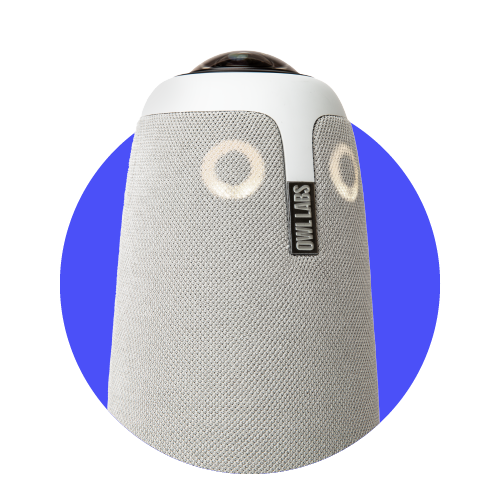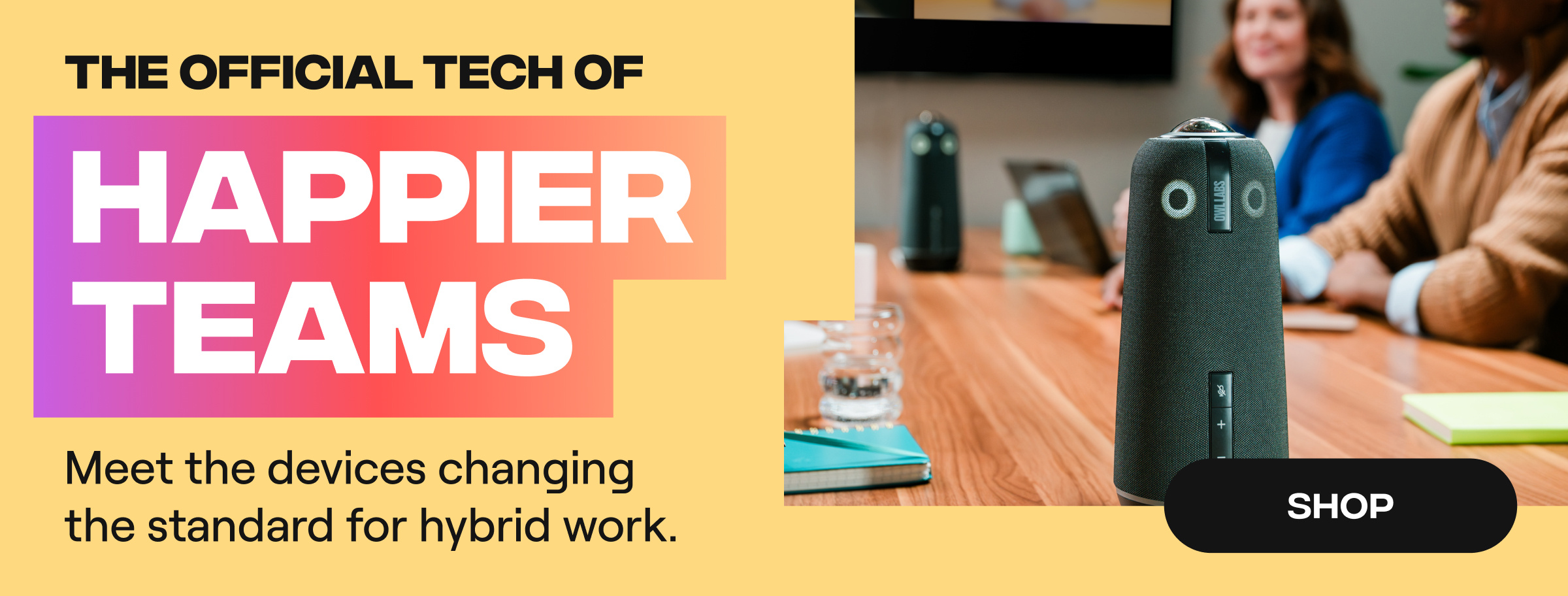Video conferencing etiquette: 10 tips for a successful video conference

Owl Labs Staff

The shift to hybrid and remote work has inextricably ingrained video conferencing into the modern business world. Next-generation video conferencing technology like - Owl Labs’ ecosystem of devices - makes hybrid meetings more immersive and natural for everyone.
In fact, 80% of executives say video conferencing is taking over audio conferencing as the go-to form of internal team communication, and 84% think it is outpacing audio conferencing in communicating with external stakeholders. That, combined with the fact that working remotely has become an increasingly dominant workforce trend, means that understanding video conference protocols is integral for succeeding in the contemporary workforce.
If you aren't familiar with the additional expectations placed upon you when you're a part of a business video conference call, that's okay. We're here to help you learn the dos and don'ts of video conferencing etiquette. Take the following information into consideration so you don't find yourself committing a major faux pas at your next big meeting or share this with a co-worker to help them out the next time they're making one of these mistakes.
Also, be sure to check out our list of the best video conferencing platforms to help you make the right selection for your next video conference.
Video Conferencing Etiquette
- Mute yourself when not speaking.
- Be on time.
- Ensure your technology works correctly.
- Use technology to fully engage remote participants.
- Choose the proper software and hardware.
- Wear work-appropriate clothing.
- Frame the camera correctly.
- Setup your space with optimal lighting.
- Look into the camera.
- Pay attention.
1. Mute yourself when not speaking.
Being told that “you’re on mute” is a borderline canonical experience for every remote worker. Forgetting once or twice is natural, but it’s important not to make it a habit. Even though you may not be speaking and think you're being quiet, most microphones can pick up minor background noises, like coughs, sneezes, or typing. These sounds can easily distract other video conferencing participants and potentially even cause annoyance.
Let's say you're typing during the meeting to try and get work done. While you may be able to get away with it, you might not want your boss calling you out for not paying attention.
Muting yourself when not actively speaking is more than just good etiquette, it’s essential for maximizing the effectiveness of hybrid meetings. For most video conferencing software, it's as simple as a click of a button.
2. Be on time.
This one should be standard for any meeting, whether it’s hybrid, remote, or in person. However, when you're participating in a video conference, it's especially important. It can be challenging to maintain the social connection and bonds that naturally occur while in person through video conferencing software. While technology has come a long way toward bridging that gap, it’s useless if you don’t show up. Give your colleagues the respect they deserve by respecting their time.
3. Ensure your technology works correctly.
Now that video conferencing has become the norm, rather than the exception, ensuring that your technology is working correctly and ready to go is an essential part of basic video conferencing etiquette. You don't want to have to delay a meeting with an important client because your video conferencing system isn't working properly. You need to do a few test runs with internal employees before trying to land the next big investor. Find someone willing to help, and make sure you understand the process fully before starting your first video conference. This will make sure everything runs smoothly during the real thing.
The latest video conferencing technology is designed to be easy to use, optimize, and monitor. Owl Labs devices can all be monitored from the Nest, giving IT managers a single location to check to make sure that each device is updated and working properly. Of course, that doesn’t mean that meeting leaders shouldn’t arrive a few minutes early to verify that everything is working as intended for themselves.
4. Use technology to fully engage remote participants.
You want your remote video conference attendees to feel like they can participate and are truly a part of the meeting. The 2022 State of Remote Work report found that being hesitant to interrupt someone who is speaking and missing visual cues by not being able to see everyone's face are two of the biggest challenges facing remote workers. s. Luckily, there are newer and smarter hardware options that are helping organizations run video conferencing meetings that are more inclusive and natural experiences than ever before.
Our very own Meeting Owl 3 + Owl Bar work together to create a front-and-center video conferencing solution that covers every angle of a meeting room. The Owl Intelligence System (OIS) helps the devices identify and automatically high active speakers, while providing a panoramic view of the entire meeting room at the top of the screen. This creates an organic, conversational atmosphere that engages remote participants far more than a simple webcam setup.
Collaborate from every angle. Shop the Meeting Owl + Owl Bar >>
5. Choose the proper software and hardware.
Having the right video conferencing hardware is only half the equation. You'll also need a software solution that your employees can use without frustration or extensive training. If you're looking for new software, check out our video conferencing comparison guide for reviews, features, and recommendations.
6. Wear work-appropriate clothing.
While it might be tempting to work in your favorite sweatshirt all day, consider wearing professional attire to any video conferences you're attending. Video call etiquette doesn’t mean that you wear something overtly fancy, but a good rule of thumb is to wear something that would be appropriate if the meeting were in person, rather than virtual.
7. Frame the camera correctly.
We've all been on video calls where we end up looking up people's nostrils or seeing the side of their face. When you're on video, make sure you frame your camera in a way that feels natural and allows you to look at the camera. Sit at eye level to the lens, and try to position yourself so that it shows the midsection up. Placing it too high leaves other participants staring down at you like a bad tv show. Putting a camera too low can lead to unflattering and awkward angles.
Utilizing front-and-center video conferencing solutions can help ensure you’re always showing your good side by covering every angle of a room. Investing in the right technology can create meeting rooms that are so well optimized for hybrid work that you don’t have to change where you’re sitting or looking.
Get a new point of view. Meet the Owl Bar >>
8. Setup your space with optimal lighting.
Poor lighting conditions have an enormous effect on the video quality that you send. It’s essential that you take the time to adequately design your space for proper video conference lighting. You'll want to make sure that there is enough light in the room you're in so that your video isn't grainy and unwatchable. Try to not mix natural lighting and office lighting unless your office bulbs are daylight white. You also don't want any faces being lit from below, as this makes you look like a cartoonish villain from a silent film. Lighting from the sides, or elevated in front of you are ideal, so try for that if you have the ability.
The number of quality ring and stream lights available today makes it easy to improve lighting for video calls. While there are a variety of lighting products out there that span the spectrum of costs, a quality setup does not have to break the bank. If remote work is going to be a consistent part of your work life, it’s essential to invest in the best video conference lighting systems you can afford.
9. Look into the camera.
A common mistake is looking at the video feed instead of the camera when speaking to a remote participant. While it may seem like the right thing to do, it actually makes it appear as if you're looking off and not paying attention. This will make you come across as more aloof and less professional. Looking into the camera lens is the equivalent of looking into the person's eyes, so practice doing so until you're comfortable with it.
10. Pay attention.
Stop checking emails or working on your PowerPoint presentation during video conferences. Not only does research suggest that only 3% of people can multitask effectively, but it’s bad video conferencing etiquette. Just like in person, it’s important to be respectful to your teammates and give them your time and attention during meetings. One of the best video conferencing tips we can offer is that if you wouldn’t do it in person, don’t do it during a remote meeting.
We've all experienced bad remote meetings. When most of us first transitioned to remote work, subpar video conferencing etiquette could be excused since everyone was still adapting to new ways of working. But now that hybrid and remote work has become the norm, there is no excuse for bad hybrid meetings. Organizations need to invest in new technology that enhances hybrid meeting equity, and individuals need to hold themselves personally accountable to basic video meeting etiquette.
For even more ways to improve your video conferences, check out these tips for getting the most out of your hybrid meetings.

%20(1).png)